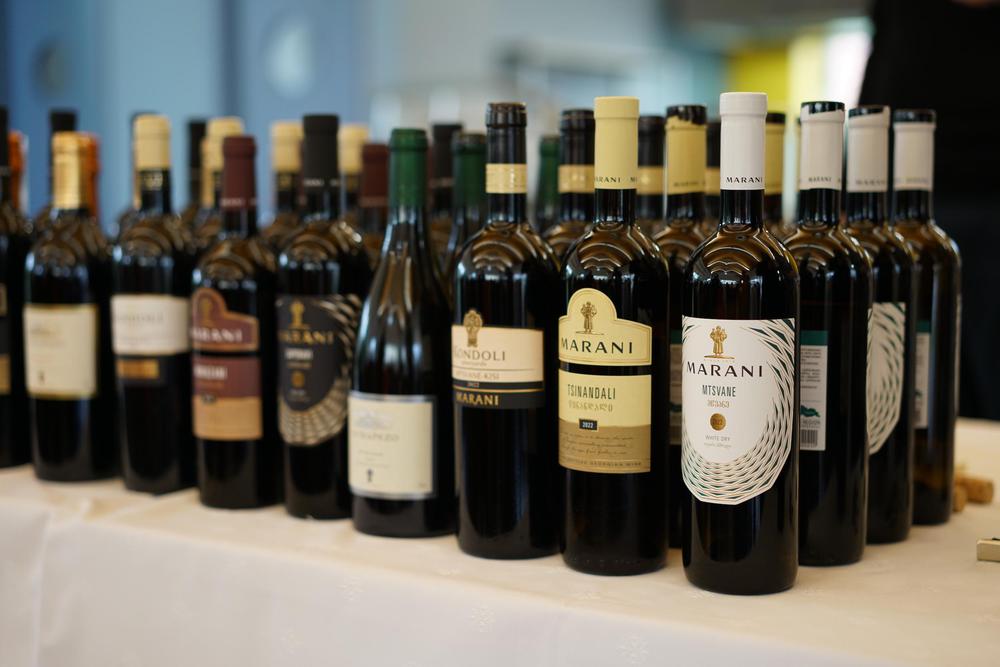Georgia's millennia-old tradition of winemaking has positioned it as a key player in the international wine trade. As we delve into the intricate web of statistics, trade dynamics, and geopolitical factors, a nuanced understanding of Georgia's role in global markets begins to unfold. From the scenic vineyards of Kakheti to international trade negotiations, Georgian wine weaves a narrative that goes beyond viticulture, encapsulating cultural richness, economic resilience, and strategic adaptability.
Georgia's Position in Global Wine Production
In the intricate landscape of global wine production, Georgia stands out as a noteworthy contributor. The year 2021 saw Georgia securing the 8th position globally in wine production, yielding approximately 4.3 million hectoliters. This signifies a steady ascent in recent years, underscoring the nation's growing significance in shaping the dynamics of the global wine market.
Georgian wine, with its diverse varieties and unique flavor profiles, has found its way to numerous corners of the world. The export statistics tell a tale of strategic expansion and diversification. In 2020, Georgia exported a staggering 94.7 million bottles of wine. The Russian market remains pivotal, constituting 61% of total Georgian wine exports. However, the country has adeptly broadened its export horizons, establishing a presence in key markets such as Ukraine, China, and Poland.
In the United States, Georgian wine exports experienced a notable surge, witnessing a 24% growth in 2020. The preference for Georgian wine in the U.S. leans towards red varieties, constituting 60% of total exports to the country. Similarly, in Poland, Georgian red wine, particularly semi-sweet varieties, has gained popularity, representing 36% of total exports.
This intricate dance of consumer preferences reflects not only the diversity of Georgian wine but also the industry's ability to tailor its products to meet varied global demands.
Navigating Global Markets
Trade Agreements and Market Access
The success of Georgian wine in international trade is intricately linked to strategic trade agreements and market access. The Free Trade Agreement (FTA) with China, a pivotal player in the global wine market, has been a catalyst for increased exports. In 2020, Georgian wine shipments to China witnessed a remarkable 94% increase, underscoring the positive impact of diplomatic and trade relations.
Additionally, the Deep and Comprehensive Free Trade Area (DCFTA) with the European Union has been instrumental in expanding market access. The agreement has not only facilitated trade with EU countries but has also positioned Georgian wine within the context of European wine standards and regulations.
Challenges and Opportunities: A Balancing Act
The journey of Georgian wine in international trade is not devoid of challenges. The COVID-19 pandemic, with its global disruptions, had a discernible impact on the wine industry in 2020. A 9% decrease in export value reflected the industry's vulnerability to external shocks. However, the resilience displayed in adapting to new market conditions and the swift recovery in subsequent years underline the industry's ability to navigate challenges.
Opportunities for growth abound, with the exploration of emerging markets and the promotion of Georgian wine tourism emerging as key strategies. The industry's proactive approach to leveraging opportunities positions Georgian wine as a dynamic player in the ever-evolving landscape of international trade.
Impact on the Georgian Economy: Beyond Borders
The success of Georgian wine in international trade reverberates beyond the vineyards, leaving a lasting imprint on the country's economy. The wine sector is a significant contributor to employment, with over 300,000 people employed in the industry in 2020. Moreover, the economic impact is profound, with the wine sector contributing 7.5% to Georgia's GDP.
In essence, Georgian wine's role in international trade extends far beyond economic metrics. It serves as a cultural ambassador, weaving narratives of tradition and resilience. As Georgia navigates the global markets, each bottle of wine carries not just the essence of the vineyards but also the history, heritage, and aspirations of a nation.
The Russian Embargo and Trade Reopening
The 2006 Russian Embargo: A Setback for Georgian Wine
The year 2006 marked a significant turning point for Georgian wine as it faced a formidable challenge in the form of a Russian embargo. Ostensibly triggered by sanitary concerns, the embargo had profound implications for the Georgian wine industry, which heavily relied on the Russian market. The sudden halt in exports to Russia, a major trading partner, created ripples that reverberated throughout the industry.
The embargo, widely perceived as a response to strained diplomatic relations between Georgia and Russia, dealt a severe blow to the Georgian wine sector. With a sudden loss of access to the Russian market, Georgian winemakers had to reevaluate their strategies and seek new avenues for international trade.
Impact on Georgian Wine Exports and Economy
The impact of the 2006 Russian embargo was felt acutely in the export figures of Georgian wine. Overnight, a significant portion of the market share disappeared, leading to a decline in export volumes and revenue. The economic repercussions were substantial, with job losses and a contraction in the contribution of the wine sector to Georgia's GDP.
While the embargo posed immediate challenges, it also spurred resilience and a strategic shift within the Georgian wine industry. Winemakers began diversifying their export destinations, exploring new markets, and focusing on quality improvement to regain global trust.
The Diplomatic Dance: Reopening of Trade in 2013
Diplomatic relations are integral to international trade, and Georgia's approach to rebuilding ties with Russia played a crucial role in the reopening of wine trade in 2013. The diplomatic dance between the two countries paved the way for the easing of tensions, ultimately resulting in the lifting of the Russian embargo on Georgian wine.
The reopening of trade with Russia in 2013 was a pivotal moment for the Georgian wine industry. It meant the restoration of access to a significant market that had been closed for almost a decade. The development signaled a diplomatic thaw and an opportunity for Georgian winemakers to reintroduce their products to Russian consumers.
Post-Reopening: Navigating Opportunities and Challenges
The reopening of trade with Russia presented both opportunities and challenges for the Georgian wine sector. On one hand, it offered a chance to regain lost market share and tap into the familiarity of Russian consumers with Georgian wine. On the other hand, it required a careful navigation of diplomatic and trade dynamics, ensuring a sustainable and mutually beneficial relationship.
The Chinese Market Dynamics
The Chinese Market: A Growing Appetite for Georgian Wine
As Georgia strategically navigated the complexities of international trade, a new player emerged on the global stage – China. The Chinese market, with its vast consumer base and evolving preferences, presented a unique opportunity for Georgian wine to establish a significant presence.
Free Trade Agreement with China: A Game-Changer
One of the pivotal moments in Georgian wine's foray into the Chinese market was the signing of the Free Trade Agreement (FTA) between Georgia and China. This agreement, inked in 2016, marked a significant milestone, creating a framework for enhanced trade relations and reducing tariffs on Georgian wine exports to China.
The impact was palpable. Georgian wine exports to China witnessed a remarkable surge, recording a staggering 94% increase in shipments in 2020. The FTA not only facilitated greater market access but also positioned Georgian wine as a competitive player in the Chinese wine landscape.
Consumer Preferences in China: Red Wines Take the Lead
Understanding consumer preferences is key to success in any international market, and China is no exception. Georgian wine found a receptive audience in China, with red wines gaining particular popularity. The rich and diverse varieties of Georgian red wines, with Saperavi being a standout, resonated well with the evolving taste preferences of Chinese consumers.
As of 2021, red wines accounted for a significant share of Georgian wine exports to China. The preference for red varieties, both dry and semi-sweet, reflected not only the adaptability of Georgian winemakers but also the alignment with Chinese consumers' evolving taste profiles.
Challenges and Future Prospects in China
While the Chinese market presented lucrative opportunities, it also posed its own set of challenges. Navigating regulatory frameworks, building brand recognition, and understanding regional preferences within China required a nuanced approach. The resilience demonstrated by Georgian winemakers in addressing these challenges showcased an industry poised for sustainable growth in the Chinese market.
The future prospects for Georgian wine in China appear promising. The growing middle class, an increasing appreciation for wine culture, and a preference for diverse and unique varieties create a fertile ground for Georgian wine to thrive. As the industry continues to invest in market strategies, collaborations, and consumer education, it is well-positioned to carve a niche in the expanding Chinese wine market.
Conclusion: A Global Odyssey Continues
In conclusion, the role of Georgian wine in international trade is a dynamic narrative, encompassing diplomatic twists, economic resilience, and strategic market penetration. From overcoming the setbacks of the 2006 Russian embargo to leveraging opportunities in the Chinese market, Georgian wine has embarked on a global odyssey that reflects not just the evolution of an industry but also the spirit of a nation.
As Georgia continues to navigate global markets, each bottle of wine becomes a testament to the intricate dance between tradition and innovation, diplomacy and trade dynamics. The journey of Georgian wine on the world stage is an ongoing saga, inviting enthusiasts and trade partners alike to savor the unique flavors and cultural richness encapsulated in every drop. The global odyssey of Georgian wine is far from over, and the next chapters promise to be as compelling and diverse as the varieties cultivated in the sun-kissed vineyards of this ancient winemaking land.

 Georgian Wine Exports
Georgian Wine Exports
 Wine Production Statistics
Wine Production Statistics
 The Impact of Georgian Wine on Economic Growth
The Impact of Georgian Wine on Economic Growth
 Georgian Wine Boom
Georgian Wine Boom




